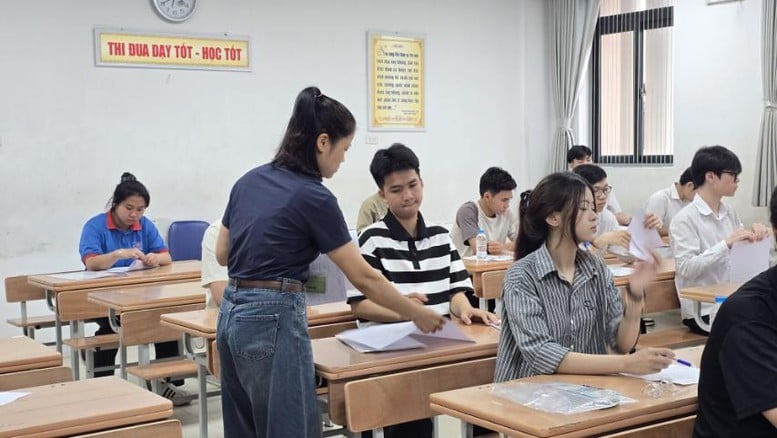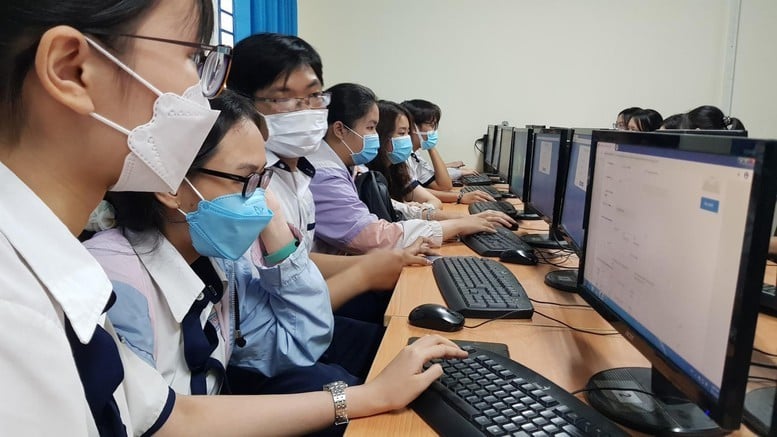
From Different Methods to Fairness in Admissions
Right from the beginning of 2025, when the draft Circular 06 was released for comments, Hanoi National University of Education (HNUE) identified the inevitability and complexity of the "equivalent conversion" problem.
The school stressed that the conversion is not intended to directly compare high school graduation exam scores and competency assessments – which differ in structure and objectives – but rather to rank candidates to ensure equal opportunities to compete, based on scores that best reflect their abilities.
The school's approach is highly academic: objective data of raw score samples are analyzed to show correlations between candidates in the same score range, score distribution density, level of competition for each score column...
The school's conversion expert team, consisting of statisticians, education assessment experts, information technology experts and experienced admissions officers, also analyzed the admissions data of the last 3 years, evaluated the effectiveness of each admissions method, compared the actual learning results of students, built the conversion software and was independently assessed by a panel of experts outside the school.
After receiving the high school graduation exam score data provided by the Ministry of Education and Training , the school's Conversion Committee solved two conversion problems:
– From the SPT exam scores of Hanoi National University of Education to the equivalent conversion score of high school graduation exam scores: Determining a strong correlation between the SPT exam results and the graduation exam results on the same set of candidates allows the application of equal percentile conversion benchmarks, adjusted by statistical techniques to overcome overlaps in areas with densely distributed scores.
– Between the high school graduation exam score combinations, use the robust Z-score method based on the median ( Robust Z-Score) to determine the deviation, ensure reliability and give results that almost match the calibration percentile table published by the Ministry.

Maintain input standards but do not create false pressure
Representatives of Hanoi National University of Education assessed that the conversion instructions of the Ministry of Education and Training are appropriate and effective if seriously implemented by schools.
With the unified direction of the leadership and available team of experts, the school not only successfully applied internally but is also ready to share experiences and support other units in the 2025 enrollment year.
Sharing the same view on the need to ensure fairness in admission, MSc. Do Ngoc Anh - Director of the Center for Communication and Admissions, Hanoi Open University - said: "It is true that this year, the average score of high school graduation tends to be lower than previous years, especially in key admission subjects such as Math and English. In that context, it is understandable that many schools have adjusted the floor score to ensure attracting suitable sources of candidates. However, reducing the floor score does not mean lowering the quality of training but is a flexible way to adapt to ensure the rights of candidates and stabilize the admission process."
From conversion techniques to system communication problems
Immediately after the Ministry of Education and Training officially closed the university and college admission registration portal, schools simultaneously announced their score conversion plans and input quality assurance thresholds.
However, the significant differences between the options – from the conversion method, compensation for each combination, to the difference in scores between the methods – are making many candidates and parents worried, especially when there is no longer a chance to adjust their wishes.
In that context, Associate Professor Dr. Tran Thanh Nam - Vice Principal of the University of Education (VNU) warned: letting each school convert without a clear standard framework or prior notice could give rise to more complex social reactions related to the differences between schools.
He analyzed: when a school adds 3-4 points to compensate for this combination, while another school does not, or only adds points for one method, public opinion will question the basis of calculation and fairness. If the explanation is too academic, the public will find it difficult to accept; if it is too simplified, its reliability will be questioned. As a result, no matter which method is applied, there will likely be mixed reactions when the admission results are announced.
Not stopping at social psychology, the inconsistency in conversion can also affect the quality of input. Associate Professor, Dr. Tran Thanh Nam gave an example: if a major such as Physics Pedagogy, which requires solid Physics skills, but the school adds points to compensate for an unsuitable combination just because the score is low, then in the end, there is a risk of leading to recruitment that is not close to the core professional requirements of the training industry.

System Responsibility and Early Notification: Indispensable Next Season
From this reality, Associate Professor Dr. Tran Thanh Nam proposed that: next year, a radical change is needed. Either the Ministry of Education and Training directly converts all methods to the 30-point system, or issues a standard table early so that schools do not "swim" in their own way. Equally important is to communicate publicly early, because "no formula is perfect, but early transparency is still better for students to prepare mentally".
He also noted that not every school has an admissions department that is good at statistics, so if left scattered, inconsistent conversion formulas will appear, which can easily trigger a wave of media crises when admission wishes are announced.
Sharing the same view, a representative of Hanoi National University of Education - one of the units that implemented the conversion the earliest and most methodically in the 2025 enrollment season - also said that from 2026, the Ministry of Education and Training should announce general objective calibration table, ensure consistency between the selection combinations and methods. At the same time, it is necessary to continue listening to social feedback, thereby perfecting the selection software and filtering fake candidates - towards a fairer, more stable and sustainable process.
The conversion problem is not just a technical issue, but part of the policy responsibility of the higher education system. 2025 is a major turning point, marking the effort to standardize admission methods. But to avoid falling into a media crisis or social suspicion, from 2026, the system needs to be more centrally coordinated, more unified and most importantly: more transparent sooner.
The Ministry of Education and Training’s issuance of the first framework guidelines on converting scores between methods is a step demonstrating its efforts to standardize the university admissions system, aiming for fairness and transparency. Reflections from practice are an important basis for the Ministry to continue adjusting policies, perfecting processes and enhancing communication, creating peace of mind for society and candidates.
Source: https://baolangson.vn/quy-doi-diem-tuyen-sinh-2025-khi-bai-toan-ky-thu-thach-chinh-sach-5054533.html


























![[Photo] National Assembly Chairman attends the seminar "Building and operating an international financial center and recommendations for Vietnam"](https://vphoto.vietnam.vn/thumb/1200x675/vietnam/resource/IMAGE/2025/7/28/76393436936e457db31ec84433289f72)








































































Comment (0)